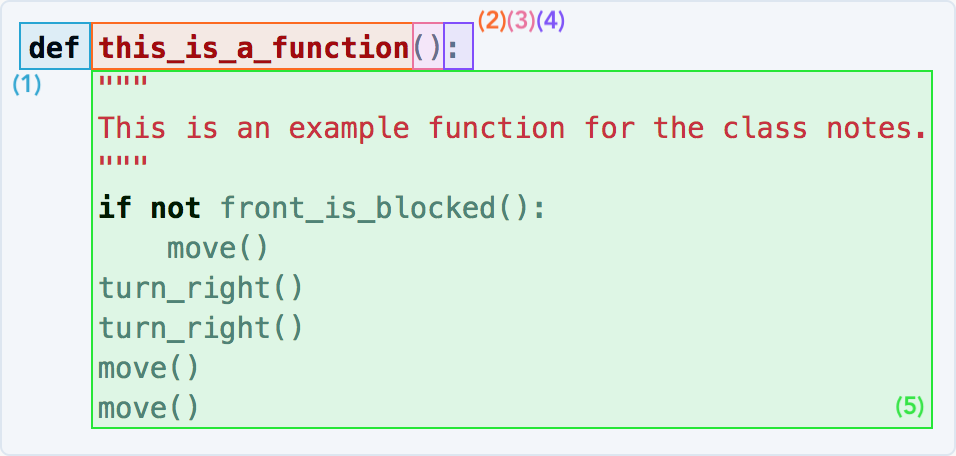So far, you have learned about PyBot and have probably come across the word “function” more than a couple of times. But, what is a function?
Function – Code that is grouped together and packaged under a name, so it can be called in one line.
Functions are the foundation of computer programming. Not only do they make it easier to read code, but they also allow us to write code that we can be reused over and over. Well-written functions are the mark of an engineer with good style.
Style - The way a body of code is written. This includes the names used for variables, the code decomposition, and the overall structure of the code.
A program with good style typically has descriptive names and short, readable functions. We will go more into this later.
Syntax Breakdown
In order to understand the way functions work, we are going to break them down to their simplest components. Let’s use a PyBot function as an example:
def this_is_a_function():
"""
This is an example function for the class notes.
"""
if not front_is_blocked():
move()
turn_right()
turn_right()
move()
move()
Functions are capable of doing many things, but here we will focus on the essential features of a function. We are going to break it down by parts.

There are five essential parts to a function.
- The
defkeyword. - The function name.
- Parentheses!
- Colon.
- The function body.
Definition Keyword - A special word in Python used to make something specific happen.
A function in Python is always started with the word def (1). Following the word def is the name of the function, in this case this_is_a_function (2), a set of parentheses (we will talk about these later) (3), and a colon (4). Following the function header (what we call parts 1-4 all together), is the body of the function (5). The body of the function consists of a comment, and of course, the code itself. Notice that the body of the function is indented; this lets the Python interpreter know that the code underneath the function belongs to this specific function and not something else.
These components are present in every single function, so if you understand this much, you are in pretty good shape!
Calling Functions
In this section we will discuss how functions are used. To call a function is to use a function.
Call – To execute the code within a function. If one were to say “I called a function” it would mean that he/she used the function in a program to execute the code within.
Functions can call other functions. In fact, this is the way that most functions are used. You have in fact, already called several functions! Each of the PyBot commands are functions. Knowing this, check out the following example of functions using PyBot commands.
def move_across():
"""
A function that allows PyBot to move across the whole board.
"""
move()
move()
move()
move()
def main():
move_across()
if __name__ == "__main__":
main()
Note: when calling a function, you must always put the parentheses after the function name. There are no exceptions!
We would say that the body of main() calls move_across(). We would also say that the body of move_across() calls the function move() four times.
Wondering about the funky statement below the main() function? That is just code that gets the program to run. Do not worry about it for now; we will explain it later. For now, just know that that statement calls main(). In this class, it will always call main(), so you can think of main() as the starting point of all projects and exercises.
Here, we see an example of the usefulness of functions. Now, a programmer can get PyBot across the field with one, descriptive function call, instead of calling move() four times. Let’s move on to writing some functions that we want to call.
Function Implementation
In this section we are going to do a brief exercise in implementing functions.
Implement – To ~write~ code! This is a technical word often used in computer science. We use this word because the word for a specific instance of written code is called an implementation. (There are many words like this that may require a bit of explanation. If you ever come across a word that is being used in a funny way, please do not hesitate to ask!)
Writing a function is not so difficult. For now, it is the simple act of coming up with a function name and writing the function body. Let’s try implementing a function in the exercise below.
Congratulations on writing your first function!
Decomposition
In the above exercise, we put the three turn_right() functions into turn_left() so that we could use them without writing them out all the way every single time. This style technique is called decomposition and is foundational to being a good computer programmer. It keeps small programs readable, and large programs from spiraling out of control.
Here is a good example of this. The following is a gif of a PyBot capable of collecting fruit on the south and east sides of the field:

Here are two implementations for the above gif. One with bad decomposition…
def main():
pick_fruit()
move()
pick_fruit()
move()
pick_fruit()
move()
pick_fruit()
move()
turn_right()
turn_right()
turn_right()
pick_fruit()
move()
pick_fruit()
move()
pick_fruit()
move()
pick_fruit()
move()
turn_right()
turn_right()
turn_right()
if __name__ == '__main__':
main()
… and one with good decomposition.
def turn_left():
turn_right()
turn_right()
turn_right()
def pick_and_move():
pick_fruit()
move()
def pick_fruit_across():
pick_and_move()
pick_and_move()
pick_and_move()
pick_and_move()
def main():
pick_fruit_across()
turn_left()
pick_fruit_across()
turn_left()
if __name__ == '__main__':
main()
See the difference? Not only is the second code block shorter, it is also much easier to read.
Always strive to decompose your code into readable chunks. If you can do everything that we have explained so far, you are well on your way to becoming an excellent computer programmer!